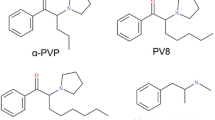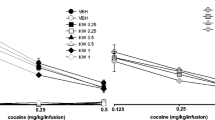Summary
Compounds showing an in vitro binding preference for the dopamine D3 vs. D2 receptors were tested for effects on locomotor activity after local application in the nucleus accumbens (N Acc) and the ventral tegmental area (VTA) of the rat brain. R-(+)-7-OH-DPAT, a dopamine D3 preferring agonist, inhibited spontaneous locomotor activity over a wide dose range after injection into the N Acc. A decrease in activity over a wide dose range was also seen after local application into the VTA of both R-(+)-7-OH-DPAT and the dopamine D2 preferring agonist (+)-3-PPP. Furthermore, (+)-3-PPP produced a dose dependent increase in activity after local application into the N Acc. The putative D3 antagonist, U99194A, with a 30 fold preference for the dopamine D3 vs. D2 receptor, produced an increase in activity when injected into the N Acc. A similar pattern were seen after infusion into the lateral ventricle. Local application into the VTA did, however, not produce any significant effects. The present results support the hypothesis that dopamine D3 receptors (in contrast to the D2 receptors) are mainly postsynaptically located where they display an inhibitory action on locomotor activity.
Similar content being viewed by others
References
Ahlenius S (1992) Effects of the local application of 3-PPP and sulpiride enantiomers into the nucleus accumbens or into the ventral tegmental area on rat locomotor activity: evidence for the functional importance of somatodendritic autoreceptors. Naunyn Schmiedebergs Arch Pharmacol 345: 516–522
Bouthenet ML, Souil E, Martres MP, Sokoloff P, Giros B, Schwartz JC (1991) Localization of dopamine D3 receptor mRNA in the rat brain using in situ hybridization histochemistry: comparison with dopamine D2 receptor mRNA. Brain Res 564: 203–219
Caine SB, Koob GF (1993) Modulation of cocaine self-administration in the rat through D3 dopamine receptors. Science 260: 1814–1816
Daly SA, Waddington JL (1993) Behavioural effects of the putative D-3 dopamine receptor agonist 7-OH-DPAT in relation to other “D-2-like” agonists. Neuropharmacology 32: 509–510
Damsma G, Bottema T, Westerink BHC, Tepper PG, Dijkstra D, Pugsley TA, MacKenzie RG, Heffner TG, Wikström H (1993) Pharmacological aspects of R-(+)-7-OH-DPAT, a putative dopamine D3 receptor ligand. Eur J Pharmacol 249: R9-R10
Dreher JK, Jackson DM (1989) Role of D1 and D2 dopamine receptors in mediating locomotor activity elicited from the nucleus accumbens. Brain Res 487: 267–277
Essman WD, McGonigle P, Lucki I (1993) Anatomical differentiation within the nucleus accumbens of the locomotor stimulatory actions of selective dopamine agonists and d-amphetamine. Psychopharmacology 112: 233–241
Feenstra MGP, Sumners C, Goedemoed JH, de Vries JB, Rollema H, Horn AS (1983) A comparison of the potencies of various dopamine receptor agonists in models for pre- and postsynaptic receptor activity. Naunyn Schmiedebergs Arch Pharmacol 324: 108–115
Haadsma-Svensson SR, Svensson KA, Waters N, Smith MW, Huff RF, Lin C-H, Carlsson A (1995) Identification of the D3 preffering antagonist [5,6-dimethoxy-2-(dipropylamino)indan]. J Med Chem (in press)
Hjorth S, Carlsson A, Clark D, Svensson K, Wikström H, Sanchez D, Lindberg P, Hacksell U, Arvidsson L-E, Johansson A, Nilsson JLG (1983) Central dopamine receptor agonist and antagonist actions of the enantiomers of 3-PPP. Psychopharmacology 81: 89–99
Hooks MS, Jones GH, Liem BJ, Justice JJ (1992) Sensitization and individual differences to IP amphetamine, cocaine, or caffeine following repeated intracranial amphetamine infusions. Pharmacol Biochem Behav 43: 815–823
Kling-Petersen T, Ljung E, Waters N, Svensson K (1995) Effects on locomotor activity after local application of (+)-UH232 in discrete areas of the rat brain. J Neural Transm [GenSect] (in press)
Kling-Petersen T, Ljung E, Wollter L, Svensson K (1995) Behavioural effects of the dopamine D3- and autoreceptor preferring antagonist, (−)-DS121, on locomotor activity and in the conditioned place preference and intracranial self-stimulation paradigms. Behav Pharmacol 6: 107–115
Landwehrmeyer B, Mengod G, Palacios JM (1993) Differential visualization of dopamine D2 and D3 receptor sites in rat brain. A comparative study using in situ hybridization histochemistry and ligand binding autoradiography. Eur J Neurosci 5: 145–153
Leao AAP (1944) Spreading depression of activity in the cerebral cortex. J Neurophysiol 7: 359–390
Lévesque D, Diaz J, Pilon C, Martres M-P, Giros B, Souil E, Schott D, Morgat J-L, Schwartz J-C, Sokoloff P (1992) Identification, characterization and localization of the dopamine D3 receptor in rat brain using 7-[3H]hydroxy-N,N-di-n-propyl-2-aminotetraline. Proc Natl Acad Sci 89: 8155–8159
Meller E, Bohmaker K, Goldstein M, Bashman DA (1993) Evidence that striatal synthesis-inhibiting autoreceptors are dopamine D3 receptors. Eur J Pharmacol 249: R5-R6
Radhakishun FS, Horn AS, Van Ree JM (1988) Desenkephalin-γ-endorphin and neuroleptics counteract the DP-7-ATN-induced hypomotility after intra-accumbens treatment. Eur J Pharmacol 147: 137–140
Sokoloff P, Giros B, Martres M-P, Bouthenet M-L, Schwartz J-C (1990) Molecular cloning and characterization of a novel dopamine receptor (D3) as a target for neuroleptics. Nature 347: 146–151
Sonesson C, Waters N, Svensson K, Carlsson A, Smith MW, Piercey PF, Meier E, Wikström H (1993) Substituted 3-phenylpiperidines: new centrally acting dopamine autoreceptor antagonists. J Med Chem 36: 3188–3195
Svensson K, Carlsson A, Huff RM, Kling-Petersen T, Waters N (1994a) Behavioral and neurochemical data suggest functional differences between dopamine D2 and D3 receptors. Eur J Pharmacol 263: 235–243
Svensson K, Carlsson A, Waters N (1994b) Locomotor inhibition by the D3 ligand R-(+)-7-OH-DPAT is independent of changes in dopamine release. J Neural Transm [GenSect] 95: 71–74
Svensson L, Ahlenius S (1983) Suppression of exploratory locomotor activity in the rat by the local application of 3-PPP enantiomers into the nucleus accumbens. Eur J Pharmacol 88: 393–397
Swanson LW (1993) Brain maps: structure of the rat brain. Elsevier, Amsterdam, p 240
Waters N, Svensson K, Haadsma-Svensson SR, Smith MW, Carlsson A (1993) The dopamine D3-receptor: a postsynaptic receptor inhibitory on rat locomotor activity. J Neural Transm [GenSect] 94: 11–19
Author information
Authors and Affiliations
Rights and permissions
About this article
Cite this article
Kling-Petersen, T., Ljung, E. & Svensson, K. Effects on locomotor activity after local application of D3 preferring compounds in discrete areas of the rat brain. J. Neural Transmission 102, 209–220 (1995). https://doi.org/10.1007/BF01281155
Received:
Accepted:
Issue Date:
DOI: https://doi.org/10.1007/BF01281155




